Red Cabbage Sauerkraut
Rich in probiotic goodness and bursting with colour, red cabbage sauerkraut makes a valuable addition to your meals. Throw in some fennel fronds, fennel seeds, ginger, and a little apple – and it’s also a food that can be quite calming for the gut.
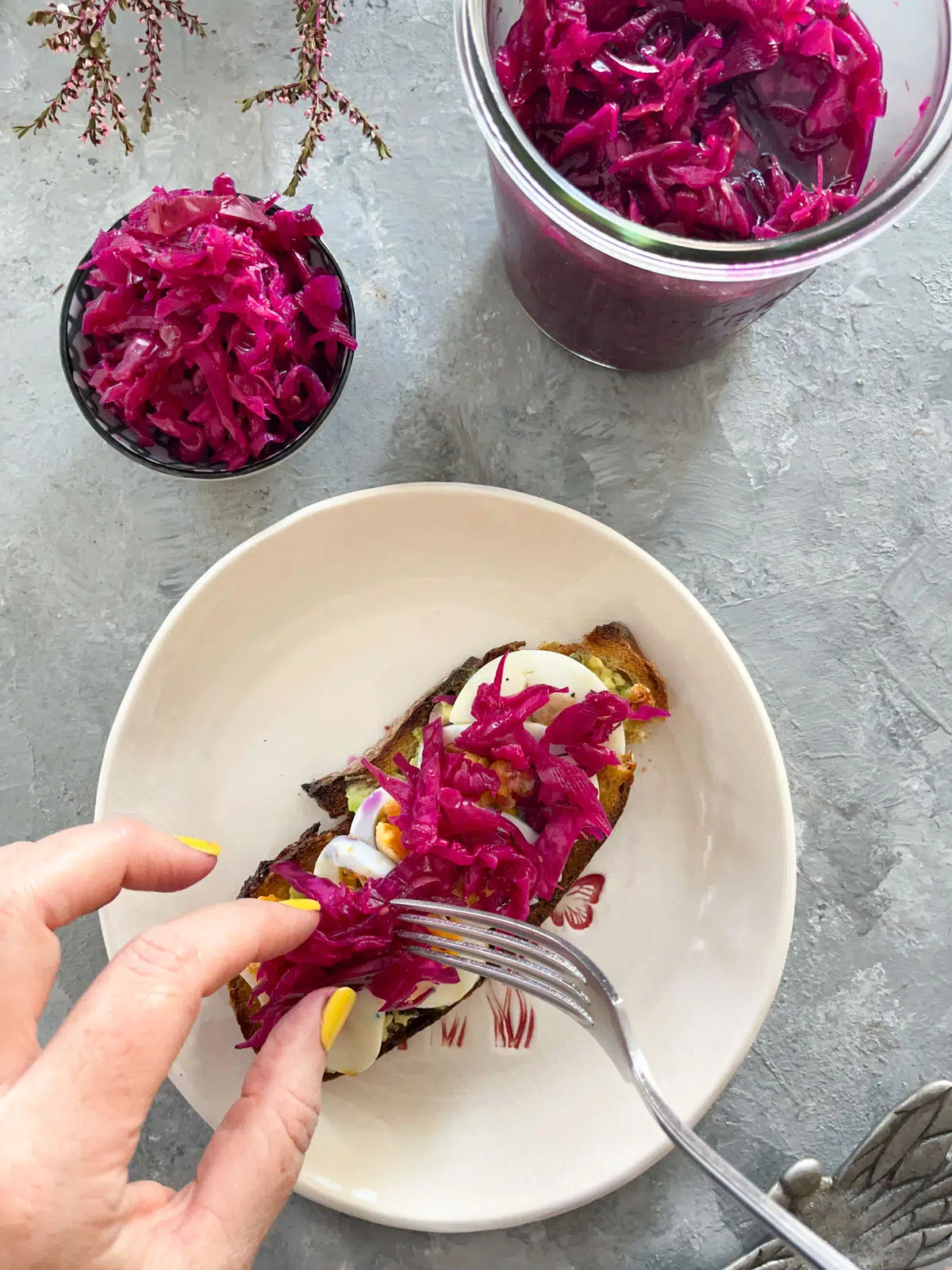
In This Article
Why Make Your Own Sauerkraut?
It’s coming on 12 years since I made my first ferment. It was the health benefits that got me hooked at the time, but also – that touch of alchemy. What’s not to love about mixing veg with some salt and watching it transform into something even more nourishing?
Making your own can be far superior to picking one up at the supermarket too. For starters, you harness the probiotic bacteria in your own environment. But also, good quality krauts aren’t always available. Many are shelf stable, which usually means they’re pasteurised and devoid of the good gut bugs we often look to these foods to provide.
Red Cabbage Sauerkraut Ingredients
The basics here are the cabbage and the salt. Everything else could be substituted with other ingredients you may prefer. For instance, you can leave out the apple and swap the fennel for other spices you like. Dill is another popular inclusion that I certainly love too.
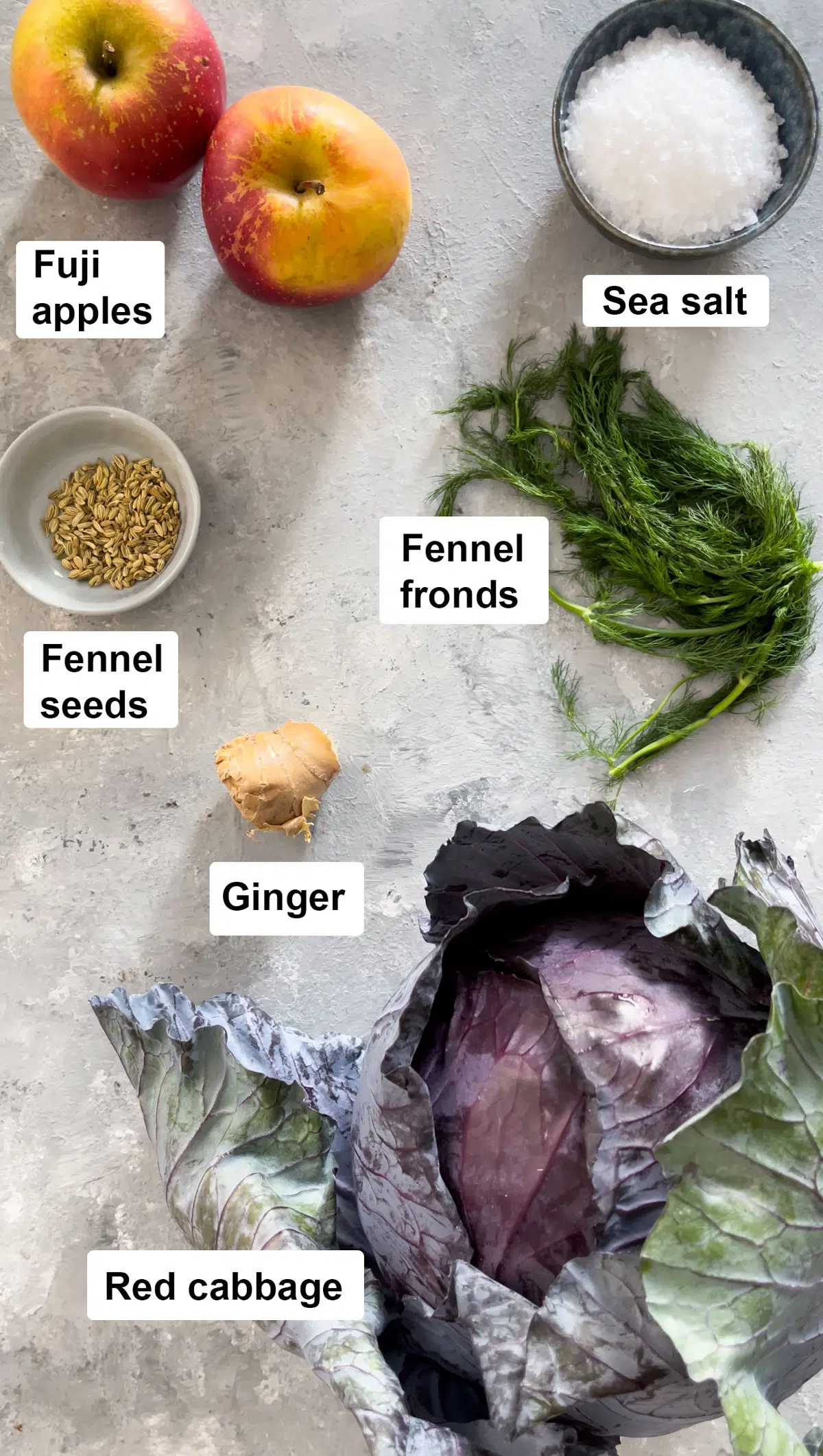
- Red cabbage – A given as the recipe name suggests. That being said if you can’t find red cabbage using green is also fine. It just won’t be anywhere near as pretty but will still taste great.
- Red apples – I used fuji apples here, as I still had some leftover from my apple and honey fruit paste. Whatever you have on hand is fine, although sweet apples work really well.
- Fennel fronds – I went foraging for wild fennel fronds for this recipe! There’s lots to be found in Sydney. It’s absolutely not necessary of course and fennel fronds from your supermarket fennel will be just fine. If you can’t find any or they’re out of season, just add 1/2 to 1 teaspoon more of fennel seeds.
- Fennel seeds – This helps to strengthen the fennel flavour in the kraut, but fennel is also a wonderful stomach settler. Great for gassy guts too, which can be a good addition if cabbage has that effect on you.
- Fresh Ginger – Just a little goes a long way, and like fennel, it does wonders for calming the gut.
- Sea salt – This is a good choice for fermenting as it doesn’t contain iodine, which can inhibit fermentation. It’s also rich in minerals as an added bonus.
Just a note on the salt – The volume of salt suggested by many a seasoned fermenter is generally 1.5 – 2% of the vegetable weight. So for example – I’ve used 2.85kg (6 pounds) here with the combination of cabbage and apples. As such, the amount of salt I need is 43g (1.5 oz), which is 1.5% of 2.85kg. I rounded it up a touch to 45g to make it an even 3 Tablespoons. This calculation makes it really easy to scale the recipe up or down depending on your needs.
How To Make This Red Cabbage Sauerkraut
I tend to think of this as a good weekend project because it can take a bit of time. That will mostly depend on how much cabbage you use and how much chopping you need to do.
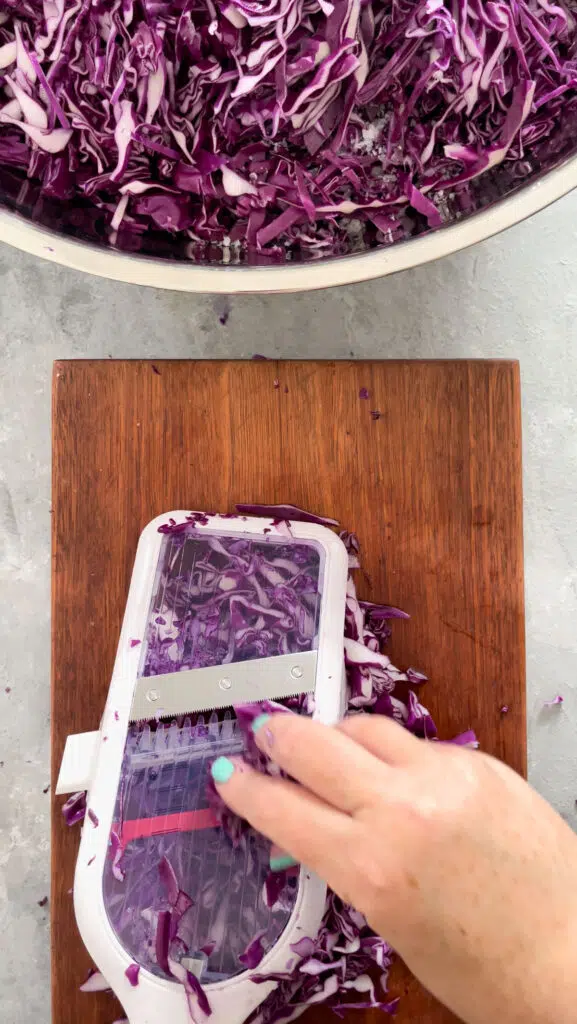
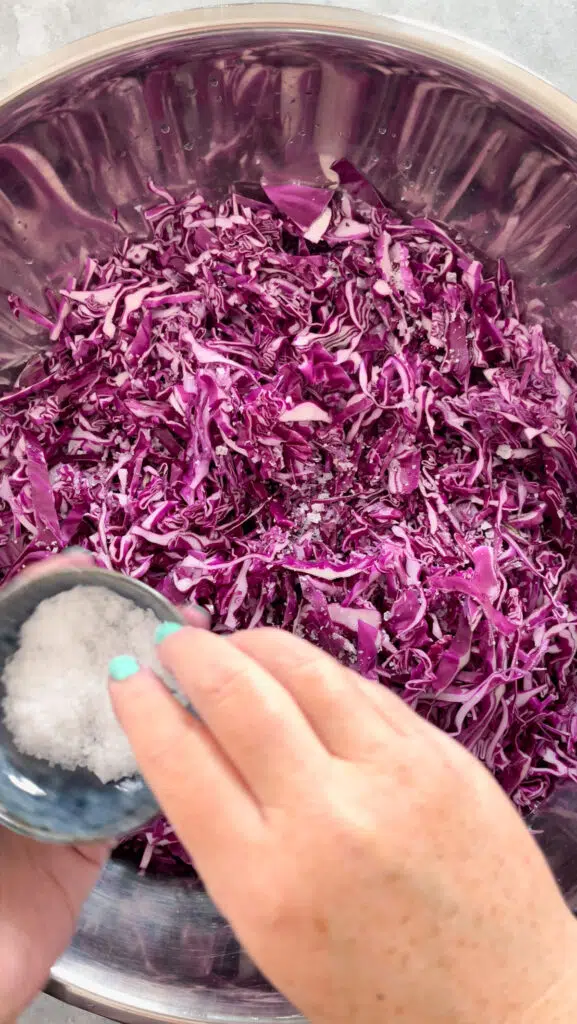
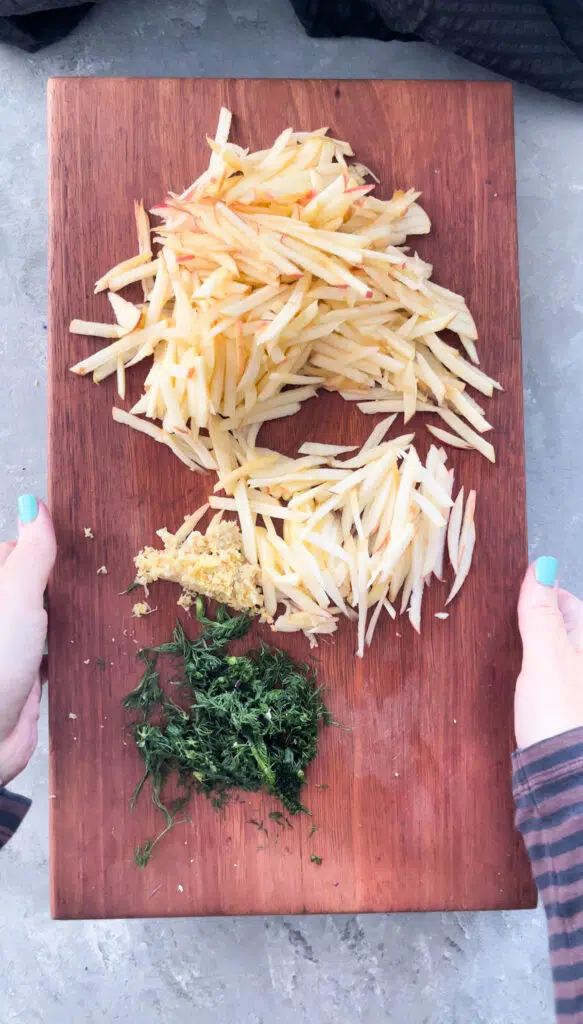
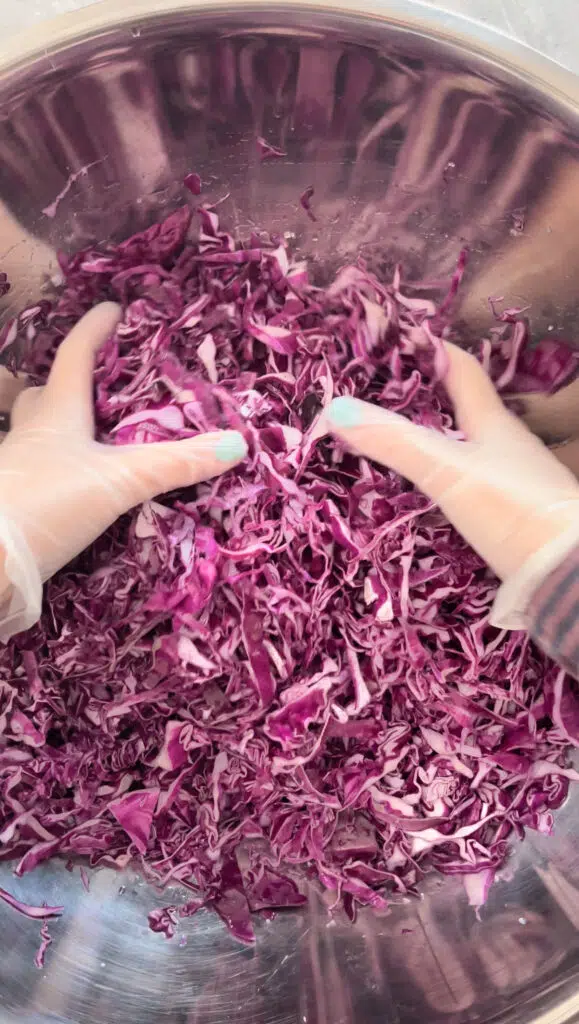
- Remove the outer leaves from the cabbage and set aside. Cut cabbage into quarters, wash, and remove the cores. Now weigh them with the apples and adjust your salt needs accordingly. If you have somewhere between 2.5 to 3kg (5.5 to 6.5 pounds) the 45g suggested here is fine.
- Finely slice the cabbage either by hand or with a mandolin and place in a large bowl.
- Sprinkle some salt over the cabbage after each quarter has been sliced, and massage it through briefly.
- Cover the bowl with a cloth and leave to sit on the bench for up to an hour. This helps draw the water out of the cabbage, which creates the brine for your crock or jars.
- Remove the cover, grate in the apple then add chopped fennel fronds, fennel seeds, and grated ginger.
- Massage everything together until well combined and plenty of liquid is in the bottom of the bowl.
- Pack the sauerkraut into a crock, place the weights on top, wipe the rim clean, and fill the moat with water.
- If packing the sauerkraut into jars leave an inch (2.5cm) head room. Fold one of the discarded outer cabbage leaves and put it on top of the kraut, wipe the rims of the jars then put the lid on. The added leaf on top ensures the sauerkraut stays submerged under liquid while fermenting. Sit the jars on plates in case they bubble over in the coming days.
- Leave to ferment on the bench for 7-10 days. If you’ve used jars – just remember to slowly release and then close the lid a couple of times a day to ‘burp’ them. This will stop any mishaps occurring from an extra lively ferment.
- Once fermented decant to jars if you used a crock, store in the fridge and enjoy!
It’s a pretty simple process and I think, one of the best ferments for a beginner to start with. If you’re still feeling a bit nervous about doing this on your own though – I can highly recommend fermentation classes with Holly Davis. They’re online, so you don’t even need to be in Sydney to partake.
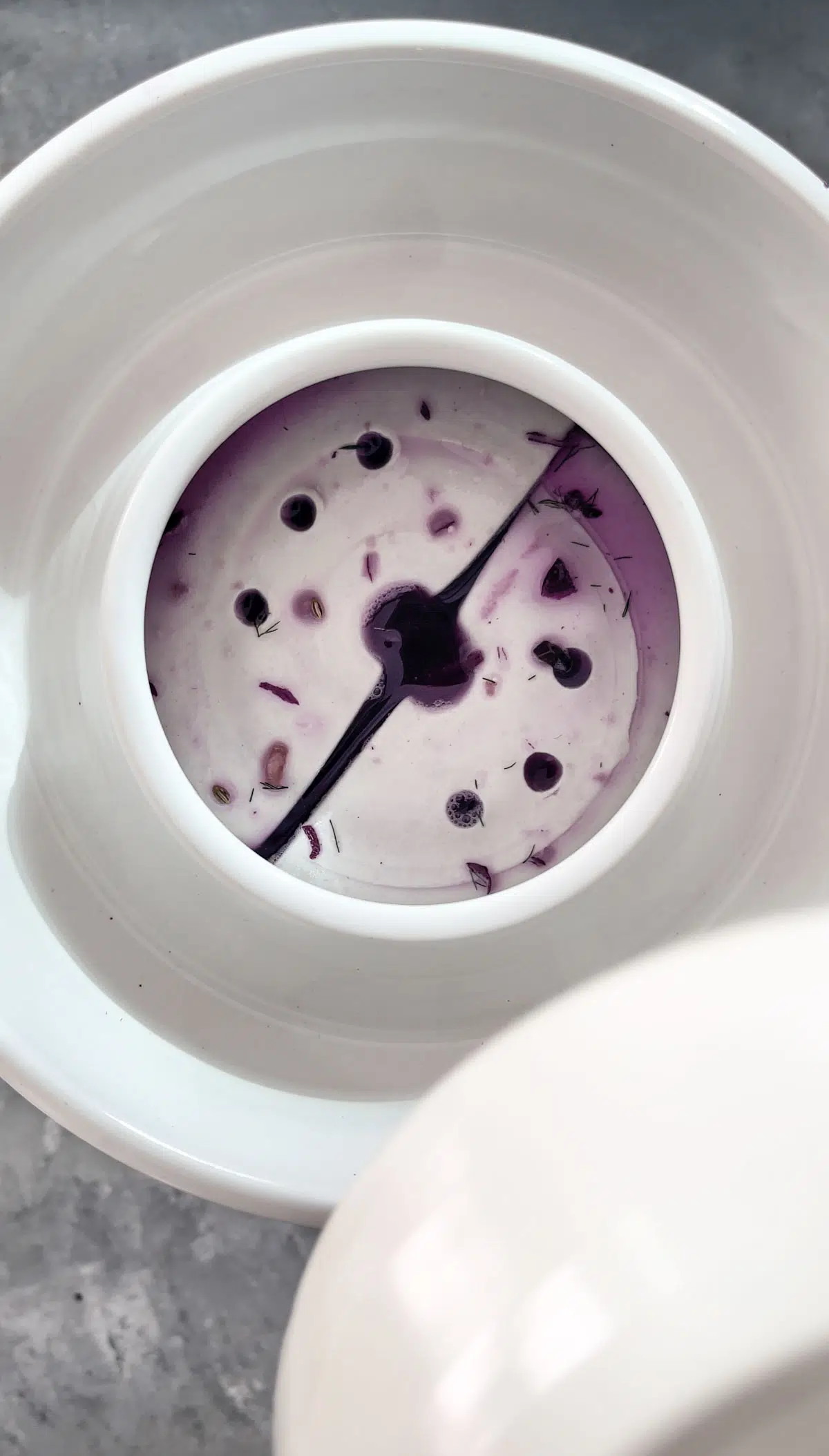
FAQ
It is a both a prebiotic and a probiotic food so that’s a definite yes. Just ensure that the sauerkraut you buy, if you’re not making your own, is not pasteurised. When its heat treated, it loses all the beneficial bacteria that we know and love it for.
Yes! We can hear a lot about botulism and the need for caution when preserving food. However, that’s less of a concern with fermenting. Certainly with fermenting fruit and vegetables anyway. In fact Sandor Katz, at one of his talks while here in Aus, said that there has never once been a reported case of botulism from fermenting fruit or veg. If that doesn’t put your mind at ease!
No, but they must be spotlessly clean, as should your hands. If not, you may find that your sauerkraut spoils as it ferments due to the wrong kind of bacteria being present. You’ll know this is happening if you see coloured moulds appear (grey, blue, pink, or black). If it does – this batch will need to be discarded.
Watch How To Make This Red Cabbage Sauerkraut
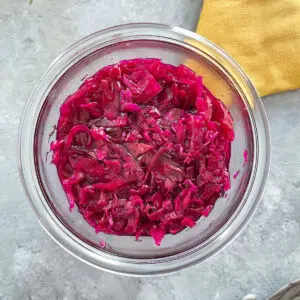
Red Cabbage Sauerkraut
Equipment
- 1 Crock or several large jars (capacity needed is 3 litre / 3 quarts total)
Ingredients
- 2.5 kg red cabbage (this was 2 cabbages for me)
- 2 large red apples, washed, cut into quarters and cored just before grating (about 350g)
- A few fennel fronds, chopped (I had 4)
- 1 inch piece of ginger, grated
- 1 tsp fennel seeds
- 3 Tbsp sea salt (see recipe note below) (45g)
Instructions
- Remove a few of the outer cabbage leaves that may look a little haggard. Keep these, as they'll come in handy when packing your jars. They won't be needed if you're using a crock.
- Cut the cabbages into quarters, wash, remove the cores and weigh together with the apples (see note below on why I weigh my ingredients). If you have somewhere between 2.5 to 3kg (5.5 to 6.5 pounds) the 45g suggested here is fine.
- Thinly slice the cabbage either by hand or with a mandolin, and place in a large bowl.
- Sprinkle some salt over the cabbage after each quarter has been sliced, and massage it through briefly.
- Cover the bowl with a cloth and leave to sit on the bench for up to an hour. This helps draw the water out of the cabbage, which creates the brine for your crock or jars.
- Remove the cover from the bowl, then cut the apple into quarters, cut out the cores and grate into the bowl. Now add the chopped fennel fronds, fennel seeds, and grated ginger.
- Massage everything together, squeezing the veg slightly as you do, until well combined and plenty of liquid is in the bottom of the bowl.
- Pack the sauerkraut into a crock*, followed by any liquid left in the bowl. Wipe the rim with a clean cloth and place the weights inside. Put the lid on, then fill the moat with water.
- If packing the sauerkraut into jars leave an inch (2.5cm) head room. Fold one of the discarded outer cabbage leaves and put it on top of the kraut, wipe the rims of the jars then put the lid on. The added leaf on top ensures the sauerkraut stays submerged under liquid while fermenting. Sit the jars on plates in case they bubble over in the coming days.
- Leave to ferment on the bench for 7-10 days. If you've used jars – just remember to slowly release and then close the lid a couple of times a day to 'burp' them. This will stop any mishaps occurring from an extra lively ferment.
- Taste your sauerkraut at day 7 and if you like it, it's ready. If you'd like it to be a little more sour leave it for a few more days.
- Once fermented decant to jars if you used a crock, store in the fridge and enjoy!
Notes
Nutrition
Pin This Recipe For Later
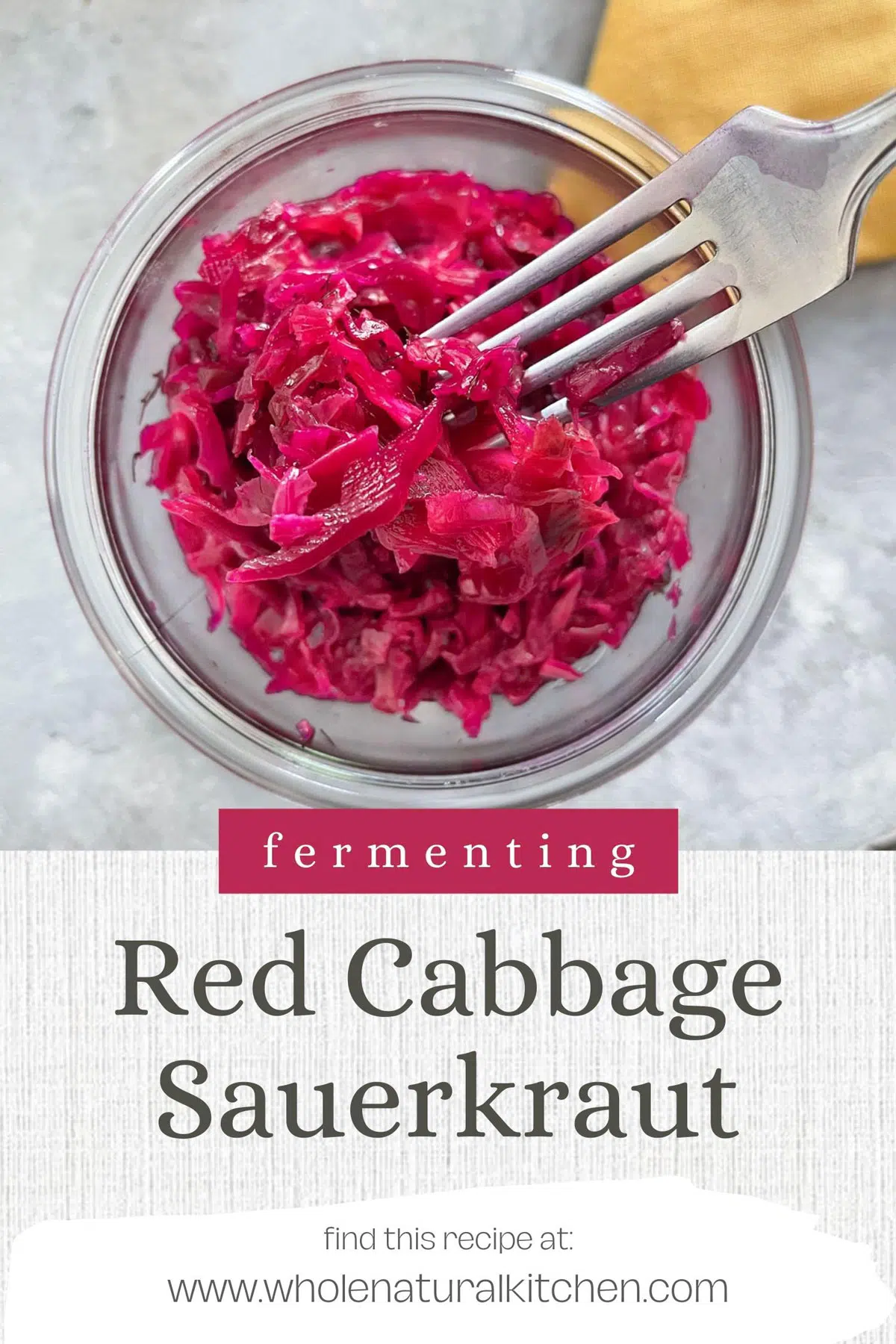
Want More Fermenting Recipe Ideas? Take A Look At These!
Never Miss A Thing!
Follow me on Facebook, Instagram, and Pinterest to keep up to date with all my latest recipes, hints, and tips.
